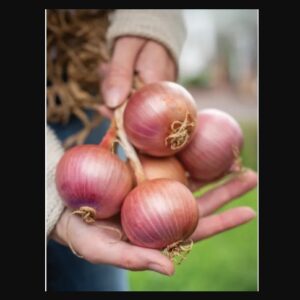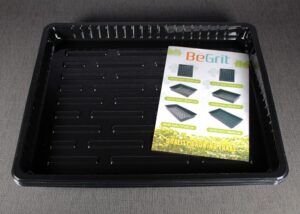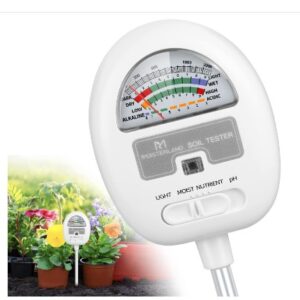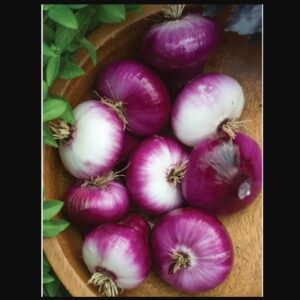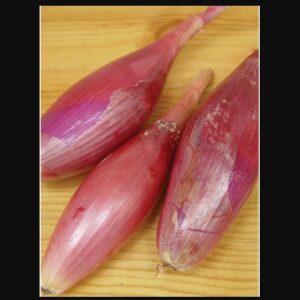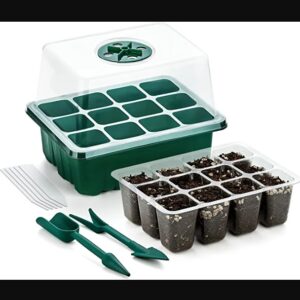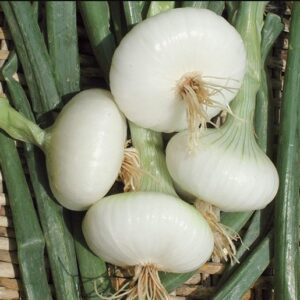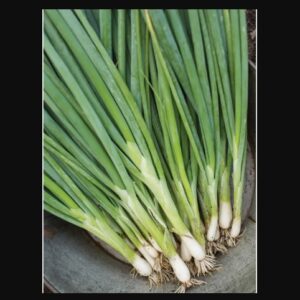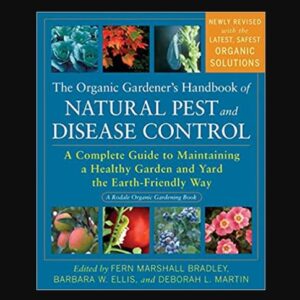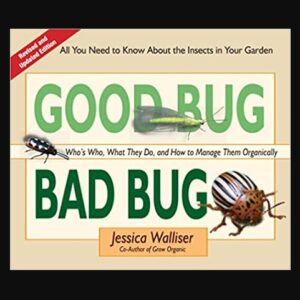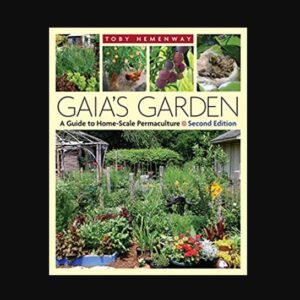How to Grow Onions at Your Homestead
Last Updated: May 7, 2023
Onions (Allium cepa) are an easy-to-grow vegetable and a staple in most kitchens. They are part of the Liliaceae crop family. They come in a variety of flavors, sizes, shapes, and colors. Onions are packed with nutrients and should be a staple in your homestead garden.
This article will cover the following topics:
- General Information About Onions
- Planting Onions and Requirements of Onions
- Planting Onions by Seed
- Planting Onions by Sets
- Planting Onions by Transplants
- Main Varieties of Onions
- Pests and Diseases of Onions
- Harvesting Onions
- How to Store Onions
- How to Save Onion Seeds
- Onion Nutrition
- Animals that can eat Onions
Disclosure of Material Connection: Some of the links in this page or post may be “affiliate links”. This means that if you click on the link, Pioneer Mountain Homestead, LLC may receive an affiliate commission at no direct cost to you. Pioneer Mountain Homestead, LLC only recommends products or services that the owners, managers, or employees of Pioneer Mountain Homestead, LLC use or believe will add value to the readers of this website. This disclosure is made with the Federal Trade Commission’s 16 CFR, Part 255: “Guides Concerning the Use of Endorsements and Testimonials in Advertising.”
General Information About Onions
| Germination temperature needed for seeds: | Seeds will germinate between 50 and 95 degrees Fahrenheit. Optimal temperature is 60 to 65 degrees Fahrenheit. |
| Germination in Days for seeds: | 4 to 28 days |
| Seed Viability: | 1 to 4 years |
| Expected seed germination: | Approximately 70% |
| Time to grow a seed to transplant: | 10 to 12 weeks |
| When to plant transplants: | 2 weeks before to 2 weeks after last frost |
| Desired growing temperature: | 55 to 85 degrees Fahrenheit |
| Average Number of Plants Needed per person per year: | 25-40 (about ¼ to ½ pound of onion sets per person) |
| Seeds per ounce: | 8,500 |
| Seeds per gram: | 300 |
| Yield per Plant: | 4 ounces |
| Plants per square foot: | 16 |
| When to direct seed: | 4 to 6 weeks before last frost |
| Fall Planting: | 6 to 12 weeks before first frost |
| Days to Harvest: | 80 to 160 days |
| Life Cycle: | Biennial |
| Soil pH: | 6.0 to 7.5 |
| Companion plants: | Beets, cabbage, carrots, celery, cucumbers, lettuce, peppers, squash, strawberry, spinach, summer savory, caraway, chamomile, flax, kohlrabi, leeks, parsnips, turnips, and tomatoes. |
| Adversary plants: | Peas, asparagus, sage, bush beans and pole beans |
| Rotation considerations: | Follow squash or lettuce. Do not follow legumes or other onion family members. |
Planting Onions and Requirements of Onions
Onions are a hardy plant with a moderate ease in growing. They are a biennial and are day length sensitive. The day length will trigger the plant to bulb. The key to getting large bulbs is to get as much vegetative growth prior to the bulb stage. If you are planting onions from seed, start them early so they can obtain the vegetative growth necessary before the day length needed for bulbs occurs. In our area of Pennsylvania (zone 6a and 6b), we often start our onion seeds at our homestead in January.
To find your U. S. Hardiness Zone, follow this link: https://planthardiness.ars.usda.gov/
In some areas of the country, onion seeds can be planted in the fall to give the onions an even longer time period to gain vegetative growth and therefore produce larger bulbs.
Onions prefer a soil pH between 6.0 and 7.5. They have a shallow root structure and are inefficient feeders, so soil needs to be rich, loose, and contain lots of organic matter. A moist soil is needed, but not wet or the roots may rot.
The best way to prepare soil for onions is to add about 2” of compost or aged manure to the top 6” of soil. Most feeding of onions occurs in this area. Onions like potassium and this can be accomplished by adding wood ashes or greensand to the soil. If the pH is low, additional lime may be necessary. Preparing the soil with a 5-10-10 fertilizer is recommended. Onions also need a regular supply of phosphorus. If onions have too much nitrogen, leafy stem growth with small root growth will occur.
Plant your onions in a warm, sunny area. They prefer an area out of the wind. Do not plant onions where alliums (i.e. onions, garlic, shallots) have been grown in the past three years. Onions must be kept weeded due to their shallow roots and thin leaves which leaves them vulnerable to overcrowding. Mulch can be used to help control weeds in the onion bed. Keep the soil moist around the onion seedlings. Onions can tolerate some drought, but it stunts the growth and alters the flavor.
The best way we’ve found to determine if your onions need water is to push your finger into the soil to the first knuckle and check for moistness. If the soil does not feel moist, then it’s time to water.
When the bulbs stop enlarging, stop watering so they begin to dry prior to harvesting. If your soil lacks nutrients, feed the onions every three weeks during growth. Many people use liquid seaweed or compost tea to feed. At our homestead we harvest pond weed from our pond and add it to the soil as an amendment.
There are three main ways to plant onions: seed, sets, or transplants. All three methods are able to be started as soon as the ground is workable.
Planting Onions by Seed
Planting onion by seed gives you the greatest number of varieties. However, the viability of onion seed decreases with years. Onion seed has one of the shortest seed lives at one to four years. At our homestead we’ve had little luck with seed over two years of age, so we would recommend using the freshest seed you can get.
To plant onion seed by direct sowing, plant the seeds up to six weeks before the last frost. Plant onion seed by either broadcast seeding or place in very shallow drills (approximately ¼” deep). Cover the seed with a thin layer of dirt and keep the ground moist. The ground should not be allowed to crust over. Germination will occur in one to four weeks.
Many believe that onions started by seed store better than those started by set.
Planting Onions by Sets
Onion sets are the small bulbs (usually 3/8” to ¾” in diameter). They are grown in crowded conditions to force the onion to bulb. Onion bulbs are typically what most people plant and can often be found at department stores and farm and garden centers. If you purchase onion sets and want bulb onions, try to purchase smaller sized bulbs. If you want scallions, go for the larger bulbs. The larger bulbs will more likely bolt and not give you the bulb shape which is perfect for scallions.
To plant onion sets, prepare your soil and push the bulb into the ground. We usually plant at 4” intervals. Make sure the root side is down when planting. Keep your sets watered but not soaking wet or you will rot the roots.
If you want to grow your own sets, place the seeds about ¼” apart and cover with a thin layer of soil or compost. Lightly water the plants and let them grow until they stunt each other’s growth. The bulbs should be no larger than 1” in diameter. When the plant’s growth is stunted, the tops will turn brown. This is your clue to dig up the bulbs and let them dry for about a week and a half. Once dry, store the bulbs below 40 degrees Fahrenheit until ready to use. Storing the bulbs in a root cellar or refrigerator works well.
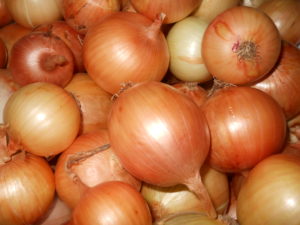
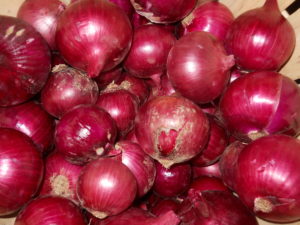
Planting Onions by Transplants
Transplants will produce the largest bulbs and the bulbs grow faster than the direct seeding method. When you transplant, the roots get disturbed and this encourages them to grow more. Transplants can be purchased from commercial establishments, but are also easy to grow yourself. Plant transplants 1” deep in prepared soil. Keep them watered, but not soaking wet.
The key to planting onions by transplants is timing with the weather and the size of the seedlings. Your goal is to try to get the plants in the ground without having them bolt. Bolting occurs when plants are vernalized. An onion plant that is vernalized will believe it went through the winter season and needs to produce seeds. To produce seeds, it will send its energy into making a center, hard stem upon which a flower will form and eventually produce seeds. It should be noted that onions at this stage are edible, but the hard central stem is often removed.
In order to not have seedlings bolt, they should be transplanted before they are ¼ inch wide and not be exposed to weather below 50 degrees Fahrenheit for more than two weeks. If you wait until the weather is consistently above 50 degrees Fahrenheit, there is a better chance that you won’t experience bolt at all. For those more daring, you can plant the seedlings up to two weeks before the last frost, but know you may have bolting if the temperature drops. Seedlings under 1/4th inch wide will most likely not bolt, so if you need to plant early and you have seedlings under 1/4th inch, you most likely won’t experience bolt.
To grow your own transplants, start the seeds as if you are growing onion sets, but instead of waiting for the onions to bulb and stunt, pull them when they are almost a ¼” in diameter. To get the seeds to germinate, keep them in a warm area at about 75 to 80 degrees Fahrenheit. Once germinated, move the seedlings to an area of 60 to 70 degrees Fahrenheit before the final step of transplanting them outside.
Main Varieties of Onions
Onions need a certain day length in order to begin to bulb. Different varieties require different day lengths. There are five main categories to consider:
1. Short Day Varieties require 10 to 12 hours of daylight to bulb.
2. Intermediate Day Varieties require 12 to 14 hours of daylight to bulb.
3. Long Day Varieties require 14 to 16 hours of daylight to bulb.
4. Very Long Day Varieties require 16 or more hours or daylight to bulb.
5. Day Neutral Varieties are not reliant on a set number of hours of daylight.
The key to choosing the correct onion variety is to select the correct variety for the day length for your area. Typically, short and intermediate day varieties are grown below the 40 degree northern latitude mark (northern hemisphere) and long day varieties are grown above the 40 degree northern latitude mark. Here at our location in Pennsylvania, we are near the 40th degree latitude so we choose intermediate, long day, or day neutral varieties.
Pests and Diseases of Onions
Tip Burn. If the tips of older leaves begin to die back, it is an indicator of tip burn. This is an indicator that the soil is lacking potassium.
Downy Mildew. Fungal disease caused by the fungus Peronospora schleideni and typically seen during wet weather. The affected leaf tissue is gray in color. The plant will later develop a purple colored, furry mold. Apply alternating applications of copper and sulfur at first sign of downy mildew if mildly affected. It is suggested to rotate the crops in a three to four year cycle. If disease has taken over, destroy or plow under the affected onions.
Botrytis (Neck Rot). This is a fungal disease caused by the fungus Botrytis alii and Botrytis spp. which inhabit the soil. These fungi are mainly wound parasites that produce many wind carried spores. The disease develops most rapidly at 60 to 65 degrees Fahrenheit. Apply alternating applications of copper and sulfur at first sign of botrytis, however it is often difficult to detect until after the harvest. Nearly all of the rot will develop in storage.
At the neck of the onion, softening of scales begins and becomes a sunken spongy area that begins to break down the onion. The onion will begin to take on a water soaked appearance. A gray to brown mold will appear on the surface of the onion and between leaves. The mold produces spores and black kernel-like resting bodies (sclerotia) about 1/8 to ¼ inch in diameter. White varieties of onions are most susceptible, but the disease affects red and yellow varieties as well.
Prevention begins by curing onions for storage properly, keeping good aeration around stored onions, and keeping the storage area dry and ventilated. A room temperature of 34 to 36 degrees Fahrenheit is ideal for storage.
Pink Root. Pink root is caused by the soil-borne fungus Pyrenochaeta terrestris. Affected onions will at first have lead colored roots which will later become pink. The disease may not kill the affected plant, but it can cause a reduction in harvest size. Pink root is best overcome by rotational planting, high fertility, and planting varieties resistant to it.
Onion Eelworm. An eelworm is a nematode. Nematodes can be beneficial or harmful. Nematodes are blind, and usually microscopic. Eelworms are more common in loamy or sandy soils, and are not common in clay soils. The eggs of nematodes remain viable in the soil for years. The signs of onion eelworm include malformed plants, yellow leaves, wilting leaves during the day, and dieback. To fight eelworms plant resistant varieties, increase organic matter which deters them, keep tools disinfected, and rotate crops.
Compost is a host to saprophytic nematodes and predacious fungi that destroy harmful nematodes like eelworm. Compost also releases fatty acids that are toxic to nematodes.
Use kelp meal and crab shell meal one month prior to planting to stimulate beneficial fungi that prey on nematodes. Cover crops of barley, castor bean, corn, cotton, vetch, rye, millet, sesame, or wheat are said to reduce populations of nematodes. Additionally, white and black mustard are reported to exude an oil that is hostile to nematodes.
Onion Maggots. Onion maggots are from a small fly in Northern United States and Canada. The larvae burrow into the bulb of the onion which stunts or kills the plant. The larvae are a white worm about 1/3” long with a pointy head. The flies are similar to a housefly, but hairier. The fly lays eggs at the base of the plant that hatch to form the worms. There are typically three generations of the onion maggots each year. The flies are prevalent in the northern and coastal regions of the U.S. where weather is cool and wet.
Row covers are indicated as a way to protect from onion maggots if you have them. Another suggestion is to plant radishes next to onions as a “trap crop”. Pull the radishes and destroy them when infested. Red onions are reported to be resistant to onion maggots. Yellow onions may have some resistance, as well.
Diatomaceous earth or wood ashes sprinkled at the base of the plant will help to prevent onion maggots.
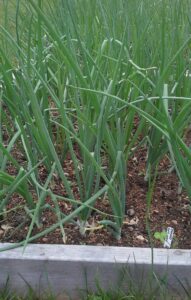
Onion Thrips. Thrips suck juices from the onion plant. Weeding is the best way to prevent onion thrips. Spanish Onions are noted as resistant to onion thrips.
Other. Other onion diseases and pests include Fusarium rot, rust, smut, onion leaf blight, purple blotch, onion smudge, sun scald, white grub, wireworm, slugs, voles, and Japanese Beetles.
Harvesting Onions
Onions can be harvested as spring onions; individual leaves can be harvested throughout the growth cycle to use in salads or as garnishes; and as mature bulbs. Bulbs occur when the plant stops growing new leaves and instead stores all its energy in the base of the leaves (the bulb). Bulbs are ready to harvest when the plant withers and falls over. This is an indicator that the plant has stored all its energy in the bulb and the cycle is completed.
Leave the plant in the ground for a week after dying. Then, pull the bulbs from the ground and allow to dry in the sun and gain a nice dry skin (this can be a few days). Move the bulbs to a warm place and cut the tops leaving 1” (unless you plan to braid them). Allow the bulbs to cure for a couple of weeks. Curing is complete when the necks are dry and the skins are papery.
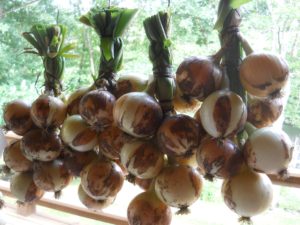
How to Store Onions
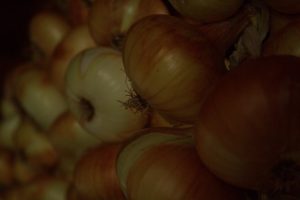
Store un-bruised onions in mesh bags or baskets in a cool, dry area at about 32 to 50 degrees Fahrenheit and 60-70% humidity (a root cellar works well). Watch for excessive moisture which can promote sprouting. Onions stored this way will last one to eight months. Some varieties store better than others so variety selection should be taken into consideration when storing onions.
Do not store onions near apples or tomatoes. They give off ethylene gas which may cause the onions to sprout.
Onions can also be canned (lasts about 12+ months), frozen (lasts about 3 months), or dried (lasts about 12 months).
How to Save Onion Seeds
Onions are biennials and will flower in the spring of the second year. In cold climates, the bulbs will need to be removed for winter and replanted in the spring. Flowers are pollinated by insects to produce seed.
When the flower heads have died and dried, remove the seeds from the flower heads. Ripe seeds are coal black and fall out easily. Make sure the seeds are dry before storing.
Onion Nutrition
Onions are a good source of Vitamin C, calcium, and potassium. They also contain the phytochemicals diallyl sulfide, kaempferol, and quereitin. The green leaves of the onion are rich in Vitamin A.
In 100 grams of green or dry onions there are 0.042 milligrams of vitamin B1, 0.125 milligrams of vitamin B2, 41 milligrams of calcium, 47 milligrams of phosphorous, 0.4 milligrams of iron, 1 gram of protein, and 42 to 45 calories. Additionally, green onions have 60 units of vitamin A and 7 milligrams of vitamin C. Dry onions do not have vitamin A and only 2 milligrams of vitamin C.
Animals that can eat Onions
Our goats nibble at onion greens, but overall, onions are not considered a good source of nutrition for animals. Onions are not recommended in quantity for animals.
Conclusion
With onions being easy-to-grow and able to provide nutritional quality to your diet, why not try growing some? Growing by sets is one of the easiest ways to grow onions and makes a great project to share with children. Onions are versatile in many meals. With all the varieties available, there is sure to be one that will add some new flavors to your meals. Just be sure to store your onions correctly and that little bit of work you do in planting will reward you year round.
Sources of Information:
Denckla, Tanya L. K. The Gardener’s A-Z Guide to Growing Organic Food. Storey Publishing, US. 2003. ISBN: 13: 978-1-58017-370-4 ISBN: 10: 1-58017-370-5
Fortier, Jean-Martin. The Market Gardener. New Society Publishers, Canada. 2014. ISBN: 978-0-86571-765-7
Jabbour, Niki. Year-Round Vegetable Gardener. Storey Publishing, US. 2011. ISBN: 978-1-60342-568-1
Rodale, J. I. and staff. How to Grow Vegetables & Fruits by the Organic Method. Rodale Books, Inc., Emmaus, PA. 1961, renewed 1999. ISBN: 0-87596-842-2
Smith, Edward C. The Vegetable Gardener’s Bible. Storey Publishing, US. 2000. ISBN: 978-1-58017-212-7
Storey, John and Martha. Storey’s Basic Country Skills. Storey Publishing, US. 1999. ISBN: 1-58017-202-4
Tozer, Frank. The Vegetable Growers Handbook. Green Man Publishing, Santa Cruz, Felton, CA. 2008. ISBN: 978-0-9773489-3-0
#pioneermountainhomestead #pmhomestead #raystown #pennsylvania #raystownfarm #homesteader #homestead #diy #homesteading #garden #gardening #gardener #farm #farmer #farming #onions #plantonions #onion #oniongarden
About the Author:
Hi. I’m Bren at Pioneer Mountain Homestead. My husband and I are full-time homesteaders in the Appalachian Mountains of south-central Pennsylvania. We have a sawmill, produce garden, honeybees, layer hens, laying ducks, pigs, and goats. Additionally, we provide boat and camper storage to nearby visitors of Raystown Lake and sell firewood and lumber. Our journey is to be as self-reliant as we can be; to live as much as we can from the resources we have at hand; to effectively be productive with as minimal environmental impact as possible; to raise food in an organic manner; and to give back to our community through education or demonstration. We are always learning, as well. Life is always an adventure! We enjoy learning from others and seeing what other people are doing as well.
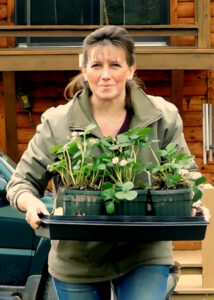
Disclaimer: Pioneer Mountain Homestead blogs and videos are for entertainment purposes only. Please use good judgement and do your own research. Our writings and videos represent our opinions and procedures. We assume no liability for actions taken in conjunction with our blogs and videos.
Disclosure of Material Connection: Some of the links in this page or post may be “affiliate links”. This means that if you click on the link, Pioneer Mountain Homestead, LLC may receive an affiliate commission at no direct cost to you. Pioneer Mountain Homestead, LLC only recommends products or services that the owners, managers, or employees of Pioneer Mountain Homestead, LLC use or believe will add value to the readers of this website. This disclosure is made with the Federal Trade Commission’s 16 CFR, Part 255: “Guides Concerning the Use of Endorsements and Testimonials in Advertising.”
